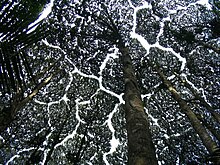Dryobalanops
 From Wikipedia the free encyclopedia
From Wikipedia the free encyclopedia
| Dryobalanops | |
|---|---|
 | |
| Dryobalanops aromatica | |
| Scientific classification | |
| Kingdom: | Plantae |
| Clade: | Tracheophytes |
| Clade: | Angiosperms |
| Clade: | Eudicots |
| Clade: | Rosids |
| Order: | Malvales |
| Family: | Dipterocarpaceae |
| Subfamily: | Dipterocarpoideae |
| Genus: | Dryobalanops C.F.Gaertn. (1805)[1] |
| Species[2] | |
| |
| Synonyms[2] | |
| Baillonodendron F.Heim (1890) | |
Dryobalanops is a genus of flowering plants and the genus of family Dipterocarpaceae. The name Dryobalanops is derived from Greek (dryas = a nymph associated with oaks and balanops = acorn) and describes the acorn-like nut. The genus has seven species, confined to the tropical forests of western Malesia (Sumatra, Peninsular Malaysia and Borneo). It is among the most abundant species of emergent trees in these forests,[1] growing up to 80 m tall.
The genus is of considerable importance as timber trees and sold under the trade name Kapur. The timber is an important heavy and durable construction timber. D. aromatica was an important source of camphor.
As the trees mature, they mutually avoid touching each other in a phenomenon known as crown shyness.
See also
[edit]References
[edit]- ^ a b Ashton, P. S. (September 2004). "Dryobalanops C.F.Gaertn.". In Soepadmo, E.; Saw, L. G.; Chung, R. C. K. (eds.). Tree Flora of Sabah and Sarawak. (free online from the publisher, lesser resolution scan PDF versions). Vol. 5. Forest Research Institute Malaysia. pp. 127–138. ISBN 983-2181-59-3. Archived from the original (PDF) on 27 September 2013. Retrieved 10 November 2007.
- ^ a b "Dryobalanops C.F.Gaertn". Plants of the World Online. Royal Botanic Gardens, Kew. Retrieved 24 September 2024.